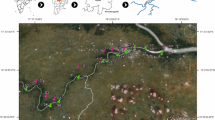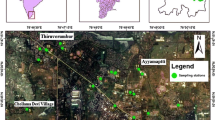Abstract
The groundwater quality for drinking, domestic and irrigation in the village Lutfullapur Nawada, Loni, district Ghaziabad, U.P., India, has been assessed. Groundwater samples were collected, processed and analyzed for temperature, pH, conductivity, salinity, total alkalinity, carbonate alkalinity, bicarbonate alkalinity, total hardness, calcium hardness, magnesium hardness, total solids, total dissolved solids, total suspended solids, nitrate-nitrogen, chloride, fluoride, sulfate, phosphate, silica, sodium, potassium, calcium, magnesium, total chromium, cadmium, copper, iron, nickel, lead and zinc. A number of groundwater samples showed levels of electrical conductivity (EC), alkalinity, chloride, calcium, sodium, potassium and iron exceeding their permissible limits. Except iron, the other metals (Cr, Cd, Cu, Ni, Pb, and Zn) were analyzed below the permissible limits. The correlation matrices for 28 variables were performed. EC, salinity, TS and TDS had significant positive correlations among themselves and also with NO −3 , Cl−, alkalinity, Na+, K+, and Ca2+. Fluoride was not significantly correlated with any of the parameters. NO −3 was significantly positively correlated with Cl−, alkalinity, Na+, K+ and Ca2+. Chloride also correlated significantly with alkalinity, Na+, K+ and Ca2+. Sodium showed a strong and positive correlation with K+ and Ca2+. pH was negatively correlated with most of the physicochemical parameters. This groundwater is classified as a normal sulfate and chloride type. Base-exchange indices classified 73% of the groundwater sources as the Na+-SO 2−4 type. The meteoric genesis indices demonstrated that 67% of groundwater sources belong to a deep meteoric water percolation type. Hydrochemical groundwater evaluations revealed that most of the groundwaters belong to the Na+-K+-Cl−-SO 2−4 type followed by Na+-K+-HCO −3 type. Salinity, chlorinity and SAR indices indicated that majority of groundwater samples can be considered suitable for irrigation purposes.








Similar content being viewed by others
References
Adhikary, P. P., Chandrasekharan, H., Chakraborty, D., Kumar, B., & Yadav, B. R. (2009). Statistical approaches for hydrogeochemical characterization of groundwater in West Delhi, India. Environmental Monitoring and Assessment, 154, 41–52.
APHA. (1985). Standard methods for the examination of water and wastewater. Washington, DC: American Public Health Association.
APHA. (2005). Standard methods for the examination of water and wastewater (21st ed.). Washington, DC: American Public Health Association.
Back, W., & Hanshaw, B. B. (1965). Chemical geohydrology. Advances in Hydrosciene, 1, 48–109.
BIS. (1998). Drinking water specifications (revised 2003). Bureau of Indian Standards.
Chow, V. T. (1964). Hand book of applied hydrology. New York: McGraw-Hill.
Degremont, G. (1991). Water treatment handbook (6th ed.). Paris, France: Lavoisier Publishing.
Eaton, F. M. (1950). Significance of carbonates in irrigation waters. Soil Science, 69, 123–133.
Goel, P. K. (2000). Water pollution — causes, effects and control. New Delhi: New Age Int. (P) Ltd..
Guo, H., & Wang, Y. (2004). Hydrogeochemical processes in shallow quaternary aquifers from the northern part of the Datong basin, China. Applied Geochemistry, 19, 19–27.
http://ghaziabad.nic.in/indexintro1.htm. Accessed 26 March 2011.
Hutchins, M. G., Smiyh, B., Rawlins, B. G., & Lister, T. R. (1999). Temporal and spatial variability of stream waters in Wales, the Welsh borders and part of the west Midlands, UK-1 major ion concentrations. Water Research, 33, 3479–3491.
Jain, C. K. (2005). Irrigation water quality in district Hardwar, Uttranchal, India. In J. Lehr (Ed.), Water encyclopedia: Ground water (pp. 204–210). USA: John Wiley.
Jain, C. K., Bandyopadhyay, A., & Bhadra, A. (2010). Assessment of ground water quality for drinking purpose, District Nainital, Uttarakhand, India. Environmental Monitoring and Assessment, 166, 663–676.
Jameel, A., & Sirajudeen, J. (2006). Risk assessment of physico-chemical contaminants in groundwater of Pettavaithalai Area, Tiruchirappalli, Tamilnadu, India. Environmental Monitoring and Assessment, 123, 299–312.
Kalra, Y. P., & Maynard, D. G. (1991). Methods manual for forest soil and plants analysis, Information Report NOR-X-319. Northwest Region, Northern Forestry Centre, forestry Canada.
Langelier, W. F. (1936). The analytical control of anti-corrosion water treatment. Journal American Water Works Association, 28(10), 1500–1521.
Mills, B. (2003). Interpreting water analysis for crop and pasture. File No. FS0334, DPI’s Agency for Food and Fiber Sciences, Toowoomba.
Mondal, N. C., Singh, V. S., Puranik, S. C., & Singh, V. P. (2010). Trace element concentration in groundwater of Pesarlanka Island, Krishna Delta, India. Environmental Monitoring and Assessment, 163, 215–227.
Naidu, A. S., Mowati, T. C., Somayajulu, B. L., & Rao, K. S. (1985). Characteristics of clay minerals in the bed loads of major river of India. Mitteilungen aus dem Geologische-Palaontologischen Instituts der Universitat Hamburg, 58, 559–568.
Piper, A. M. (1944). A graphic procedure in the geochemical interpretation of water analyses. Transactions American Geophysical Union, 25, 914–928.
Piper, A. M. (1953). A graphic procedure in the geochemical interpretation of water analyses. US Geol. Survey Groundwater, Note 12, Washington D.C.
planningcommission.nic.in/aboutus/committee/wrkgrp11/wg11_rivers.pdf. (April 25, 2011).
Ravikumar, P., Somashekar, R. K., & Angami, M. (2010). Hydrochemistry and evaluation of groundwater suitability for irrigation and drinking purposes in the Markandeya River basin, Belgaum District, Karnataka State, India. Environmental Monitoring and Assessment, in press.
Richards, L. A. (1954). Diagnosis and improvement of saline and alkali soils, U.S. Dept. of Agriculture.
Ryznar, J. W. (1944). A new index for determining the amount of calcium carbonate scale formed by water. Journal American Water Works Association, 36(3), 472–494.
Shankar, B. S., Balasubramanya, N., & Reddy, M. T. M. (2008). Impact of industrialization on groundwater quality — a case study of Peenya industrial area, Bangalore, India. Environmental Monitoring and Assessment, 142, 263–268.
Sharma, D. R. R., & Rao, S. L. N. (1997). Fluoride concentration in groundwater of Vishakhapatanam, India. Bulletin of Environmental Contaminant Toxicology, 58, 241–247.
Singh, K. P., Malik, A., Mohan, D., Singh, V. K., & Sinha, S. (2006). Evaluation of groundwater quality in Northern Indo-Gangetic alluvium region. Environmental Monitoring and Assessment, 112, 211–230.
Singh, M., Ansari, A. A., Muller, G., & Singh, I. B. (1997). Heavy metals in the freshly deposited sediments of the Gomti river (a tributary of the Ganga river): effect of human activities. Environmental Geology, 29, 246–252.
Soltan, M. E. (1998). Characterization, classification, and evaluation of some groundwater samples in upper Egypt. Chemosphere, 37, 735–745.
Soltan, M. E. (1999). Evaluation of groundwater quality in Dakhla Oasis (Egyptian Western Desert). Environmental Monitoring and Assessment, 57, 157–168.
Tank, D. K., & Chandel, C. P. S. (2010). A hydrochemical elucidation of the groundwater composition under domestic and irrigated land in Jaipur City. Environmental Monitoring and Assessment, 166, 69–77.
Vasanthavigar, M., Srinivasamoorthy, K., Vijayaragavan, K., Ganthi, R. R., Chidambaram, S., Anandhan, P., et al. (2010). Application of water quality index for groundwater quality assessment: Thirumanimuttar sub-basin, Tamilnadu, India. Environmental Monitoring and Assessment, 171, 595–609.
Younger, P. L. (2007). Groundwater in the environment: An introduction. Oxford: Blackwell Publishing.
Acknowledgements
Financial support (PAC/SES/DM/UGC/0210113-491) provided by the University Grant Commission New Delhi is gratefully acknowledged. One of the authors (VKS) is also thankful to the UGC for providing Dr. D.S. Kothari a postdoctoral fellowship.
Author information
Authors and Affiliations
Corresponding author
Rights and permissions
About this article
Cite this article
Singh, V.K., Bikundia, D.S., Sarswat, A. et al. Groundwater quality assessment in the village of Lutfullapur Nawada, Loni, District Ghaziabad, Uttar Pradesh, India. Environ Monit Assess 184, 4473–4488 (2012). https://doi.org/10.1007/s10661-011-2279-0
Received:
Accepted:
Published:
Issue Date:
DOI: https://doi.org/10.1007/s10661-011-2279-0




